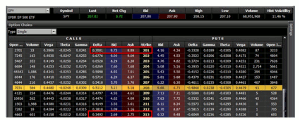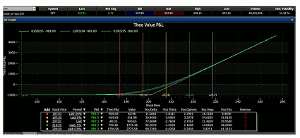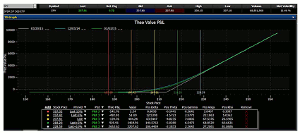Today, options expert Russ Allen, of Online Trading Academy, shares a question-and-answer between him and an options trader, which others could find helpful, regarding the similarities, and more importantly, the differences between in-the-money and out-of-the-money options.
Question: As a bullish position, can you compare the advantages and disadvantages of buying one contract of an in-the-money Call option with a Delta of 70, versus buying two out-of-the-money contracts with a Delta of 35 each (also a Delta of 70 total)?
Answer: This is a sophisticated question. To answer it, we have to explain that Delta is the percentage of the next one-point price movement of the stock that will be experienced by the option. So the value of a call option with a Delta of 70 would rise by 70 cents, if the underlying stock went up by one dollar. And if-instead of that call option-we select one with a Delta of 35, but buy two of them, then that position would also profit by 70 cents ($.35 times 2) for the next one-dollar move up in the stock. Are these positions equivalent?
The answer is that they are equivalent only for the next one-dollar move in the stock and only if that one-dollar move happens today, with no change in market expectations. In other words, no, they are not.
Now let's look at the pros and cons of each one.
As an example, we'll use call options on (SPY), the exchange-traded fund that tracks the S&P 500 index.
On December 3, 2014, SPY closed at $207.89, a new all-time closing high, by the way. On that day, a partial option chain for the March 2015 options looked like this:
Figure 1-SPY March Options as of December 3, 2014

>Notice the two red rectangles above.
Click to Enlarge
The Bid and Ask prices for the 201-strike calls, with a delta of .7001, were at $9.73 and $9.89. The midpoint between the Bid and Ask would be $9.81. The gold highlight at the 208 strike shows the dividing line between calls that were in the money like this one, and calls that were out of the money.
The Bid and Ask prices for the 213-strike calls, meanwhile, with a delta of .3492 each, were at $2.69 and $2.75, with a midpoint therefore at $2.72.
Two of the out-of-the-money 213 calls could have been bought for $272 X 2, or $544. This was considerably cheaper than the cost of one 201-strike in-the-money call, at $ 981.
Each position (one of the 201 calls or two of the 213 calls) would show a profit of $70 if SPY's price increased by $1.00 per share today.
Now let's look at a P/L diagram for each position. On each of the diagrams below, I've placed markers at the current price, at 5% and 10% below the current price and at 5% and 10% above. This is so that we can compare different scenarios.
NEXT PAGE: A Different Picture Emerges
|pagebreak|Here is the diagram of the one 201 call:
Figure 2-P/L Diagram for One SPY 201 March Call
And here is the diagram for a position consisting of two 213-strike calls:
Figure 3-P/L Diagram for Two March 213 SPY Calls
Note that I selected the March call options three months out and I'm comparing the results of the two positions as of one month from now, on January 3, 2015. The comparison would be much different if made as of the expiration date, which is how the standard P/L diagram works. In that case, the breakeven price on the 213 calls would be so high that it would be nearly impossible to make money on them and that possibility would probably be dismissed.
But if each position is only held during the time in its life when its time value is not deteriorating too rapidly, as shown here, then a different picture emerges.
The two 35-delta calls make more, or lose less, at any SPY price level, than the single 70-delta call, assuming no change in Implied Volatility; except where SPY is unchanged a month from now. In that case, the 35-delta calls lose $139 compared to the 70-delta call's $80 loss. So far, a definite win for the 35-delta calls.
One potential disadvantage of the 35-delta calls is that they have a higher Vega value, meaning that they will suffer more in case Implied Volatility drops. If SPY should continue to advance, a drop in IV is likely. This would hurt the 35-delta calls more. A drop in IV from its current 12% back down to the recent lows of 8%-a 4-point drop-would cost the 70-delta call somewhere between $3-30, depending on the price of SPY, while hurting the 35-delta calls by anywhere from $2-69. Close enough to be called a tie.
Along with the somewhat higher Vega exposure, the two 35-delta calls also have higher negative Theta, meaning that after this first 30 days, they would suffer more from time decay. Since we would have no intention of holding them longer than 30 days, time decay after that would not matter to us, so we can disregard this.
In the end, it turns out that there are definite advantages to using the two out-of-the money options, as long as we do not hold them after 30 days. Most comparisons are equal or better than the one 70-delta call and the cost is considerably less. The key is that we must not hold them close to their expiration date, where Theta would overtake their advantages.
Being able to compare different positions requires good software tools, as well as the ability to interpret the information they provide.
By Russ Allen, Instructor, Online Trading Academy
a






















